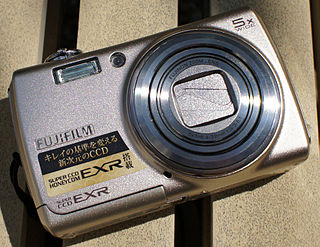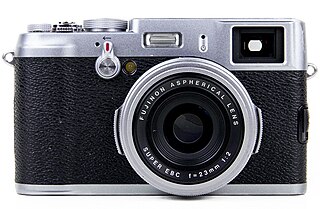
Fujifilm Holdings Corporation, trading as Fujifilm, or simply Fuji, is a Japanese multinational conglomerate headquartered in Tokyo, Japan, operating in the realms of photography, optics, office and medical electronics, biotechnology, and chemicals.

An autofocus optical system uses a sensor, a control system and a motor to focus on an automatically or manually selected point or area. An electronic rangefinder has a display instead of the motor; the adjustment of the optical system has to be done manually until indication. Autofocus methods are distinguished as active, passive or hybrid types.

Super CCD is a proprietary charge-coupled device that has been developed by Fujifilm since 1999. The Super CCD uses octagonal, rather than rectangular, pixels. This allows a higher horizontal and vertical resolution to be achieved than a traditional sensor of an equivalent pixel count.

The FujifilmFinePix F series is a line of compact digital cameras that was known for its low-light performance in 2005, with relatively low image noise and natural colors even at high ISO settings. With its relatively large, but moderate resolution Super CCD sensors, it concentrated on image quality, and low-light shooting without flash, which was mostly restricted to prosumer models at the time.

The Fujifilm FinePix A series of digital cameras consists of the company's entry-level point and shoot models. The A series was created in late 2001 and was expanded a few years later when Fujifilm transitioned to a fully alphanumeric system of naming their digital cameras.

The Fujifilm FinePix S and HS-series of digital cameras consists of the company's DSLR system and bridge camera models.

The Fujifilm FinePix products are a line of digital cameras produced by Fujifilm. They include compact point and shoot models, tough, waterproof models, bridge digital cameras, digital SLRs and mirrorless cameras. Many use Fujifilm's proprietary Super CCD technology sensors and CMOS sensors for high-end models.
The Fujifilm FinePix Z-series of digital cameras consists of the company's ultra-slim and lightweight point-and-shoot digital cameras. All Z-series cameras feature non-protruding folded optic design lenses and sliding lens covers, excluding the waterproof Z33WP, which has no lens cover. The w early Z-series cameras featured Fujifilm's Super CCD sensor, while later ones use other CCD sensors. Some newer models such as, the Z700EXR, Z800EXR, Z900EXR, and Z1000EXR, use the EXR-CMOS sensors.

An articulating screen is a built-in small electronic visual display which is not fixed, but rather can be repositioned using a hinge or pivot. The articulating screen is known under different other names such as flip-out screen, flip screen, adjustable screen, articulated screen, or hinged screen. According to the way it moves, there are four main types:
- The display moves around one axis, so that it only tilts. It is called tilting screen or tiltable screen.
- The display tilts horizontally both up and down and also vertically. This type is called double-hinged tilting screen, two-axis tilting screen, three-direction tilting screen or screen with 3-way tilt.
- The display moves around two axes which are at a right angle to each other, so that the screen both tilts and swivels. This type is called swivel screen. Other names for this type are vari-angle screen, fully articulated screen, fully articulating screen, rotating screen, multi-angle screen, variable angle screen, flip-out-and-twist screen, twist-and-tilt screen and swing-and-tilt screen.
- The display is mounted on a fully-articulating hinge that itself is attached to a tilting plate. Such display can be extended out from the back of the camera, ensuring it stays clear of the camera's left-mounted ports when flipping it out to the side. This type of articulating screen is called tilt-and-articulating screen.
- The display moves into a variety of angles; it tilts horizontally and vertically and also rotates to a certain extent while staying aligned with the lens axis. It still can not be turned all the way up, down or to the side to be seen from the front of the camera for self-portraits. This type of articulating screen is called cross-tilt screen, flexible-tilt screen or flex-tilt screen.
The Fujifilm FinePix S200EXR is a digital bridge camera from Fujifilm introduced in July 2009.

The Fujifilm FinePix HS10 is an ultrazoom bridge camera from Fujifilm that was announced in February 2010. It is the first model of the Fujifilm FinePix HS series.

The Fujifilm X series is a line of digital cameras produced by Fujifilm. The series encompasses fixed lens and interchangeable lens mirrorless cameras and premium compact point-and-shoot cameras aimed at consumer, enthusiast and professional photographers. The X series is part of the larger FinePix range of digital cameras from Fujifilm.

The Fujifilm FinePix XP-series of digital cameras consists of the company's tough, waterproof and lightweight point-and-shoot digital cameras. All XP-series cameras feature some degree of waterproofing and shockproofing which varies from model to model. The range began in 2009 with the launch of the Fujifilm FinePix XP10. A few of the models also incorporate in-built GPS tagging.

The Fujifilm FinePix HS is a series of bridge cameras that started in February 2010 with the HS10 model. The special feature of the HS cameras is the manual zoom that - otherwise common only with system cameras - allows a quick and precise change of the focal length but demands two-handed operation.

The Fujifilm X100 is a series of digital compact cameras with a fixed prime lens. Originally part of the FinePix line, then becoming a member of the X series from Fujifilm, the X100 series includes the FinePix X100,X100S,X100T,X100F, and X100V. They each have a large image sensor and a 23 mm lens. All five cameras have received generally positive reviews.

The Fujifilm FinePix HS50EXR is a DSLR styled ultra-zoom bridge camera announced by Fujifilm on January 7, 2013. It is the last model of the Fujifilm FinePix HS series. At the time of its release, it competed most closely with the Canon PowerShot SX50 HS, another ultra-zoom bridge camera with raw capability. The SX50 has 20% longer maximum effective focal length, but the HS50 has 33% more resolution on the sensor.

The Fujifilm FinePix HS30EXR or Fujifilm FinePix HS33EXR is a DSLR-styled digital ultrazoom bridge camera announced by Fujifilm on January 5, 2012. Its sister model, known as the Fujifilm FinePix HS25EXR or Fujifilm FinePix HS28EXR, and HS33, HS35. Is identical HS25EXR and HS28EXR except for a lower resolution viewfinder, the use of standard AA batteries rather than the model-specific lithium battery of the HS30EXR, and the omission of RAW support in the HS25EXR. Loaded with batteries and memory card, the HS30EXR weighs 687 grams compared to the HS20EXR's 730 grams.

The Fujifilm X10 is a 2/3 sensor digital compact camera announced by Fujifilm on September 1, 2011. At the time of its release, it competed most closely with the Panasonic Lumix DMC-LX5, Olympus XZ-1, Canon PowerShot G1 X and Sony Cyber-shot DSC-RX100, and was subsequently named a 2013 iF product design award recipient.















